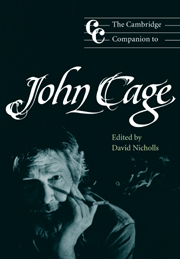3 - Cage and Asia: history and sources
from Part I - Aesthetic contexts
Published online by Cambridge University Press: 28 September 2011
Summary
“What I do, I do not wish blamed on Zen ... ”
(Cage 19 58–59 b, p. 79 )John Cage and Asian music
In determining the legitimate impact of Asian culture on John Cage's development, a clear distinction must be made between those influences that are purely musical and those that are philosophical in nature. As to the former, there is little if anything in Cage's music that suggests any kind of compelling interest in the musics of Asia, and even less that might constitute direct stylistic borrowing. Certainly in his early years, Cage had ample opportunity to be exposed to Asian music, whether in California, in New York while studying with Cowell (1934), or through longstanding friendships with others whose interest in this music was pronounced, such as Lou Harrison or sculptor Richard Lippold. Furthermore, during the 1940s it was popular among critics and sophisticated listeners to equate Cage's percussion ensemble works with the gamelan or interpret the prepared piano's delicate timbres as evidence of musical orientalism. Indeed at one point, Cage himself commented that his square-root method of rhythmic organization was in part “a structural idea not distant in concept from Hindu tala (except that tala has no beginning or ending, and is based on pulsation rather than phraseology) …” (Cage 1951, p. 63). However, such comparisons, whether drawn by critics or Cage himself, are actually quite superficial, and no significant structural or procedural affinities between Cage's oeuvre and the music of Asia have been demonstrated to date.
- Type
- Chapter
- Information
- The Cambridge Companion to John Cage , pp. 41 - 60Publisher: Cambridge University PressPrint publication year: 2002
- 3
- Cited by

